Understanding Multiple Access Techniques
VerifiedAdded on 2020/03/01
|7
|1428
|41
AI Summary
This assignment delves into the world of multiple access techniques used in wireless communication systems. It focuses on three primary methods: Frequency Division Multiple Access (FDMA), Time Division Multiple Access (TDMA), and Code Division Multiple Access (CDMA). The assignment explains how each technique allocates and manages transmission resources, highlighting their strengths and limitations. A comparison between FDMA and CDMA is also presented, shedding light on their distinct approaches to multiplexing signals.
Contribute Materials
Your contribution can guide someone’s learning journey. Share your
documents today.

Running head: ASSIGNMENT 1
Assessment item Two
[Student Name Here]
[Institution’s Name Here]
[Professor’s Name Here]
[Date Here]
Assessment item Two
[Student Name Here]
[Institution’s Name Here]
[Professor’s Name Here]
[Date Here]
Secure Best Marks with AI Grader
Need help grading? Try our AI Grader for instant feedback on your assignments.
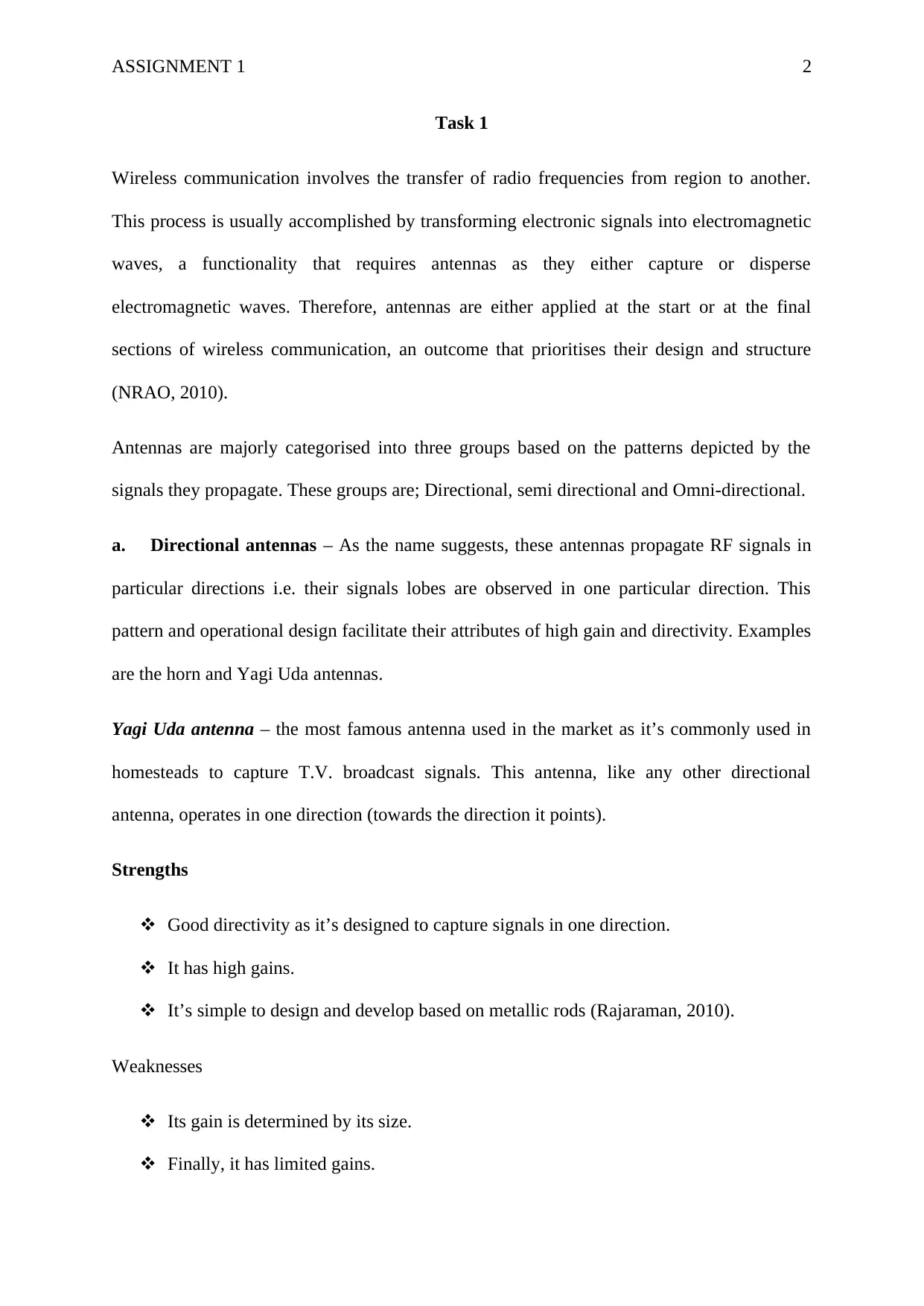
ASSIGNMENT 1 2
Task 1
Wireless communication involves the transfer of radio frequencies from region to another.
This process is usually accomplished by transforming electronic signals into electromagnetic
waves, a functionality that requires antennas as they either capture or disperse
electromagnetic waves. Therefore, antennas are either applied at the start or at the final
sections of wireless communication, an outcome that prioritises their design and structure
(NRAO, 2010).
Antennas are majorly categorised into three groups based on the patterns depicted by the
signals they propagate. These groups are; Directional, semi directional and Omni-directional.
a. Directional antennas – As the name suggests, these antennas propagate RF signals in
particular directions i.e. their signals lobes are observed in one particular direction. This
pattern and operational design facilitate their attributes of high gain and directivity. Examples
are the horn and Yagi Uda antennas.
Yagi Uda antenna – the most famous antenna used in the market as it’s commonly used in
homesteads to capture T.V. broadcast signals. This antenna, like any other directional
antenna, operates in one direction (towards the direction it points).
Strengths
Good directivity as it’s designed to capture signals in one direction.
It has high gains.
It’s simple to design and develop based on metallic rods (Rajaraman, 2010).
Weaknesses
Its gain is determined by its size.
Finally, it has limited gains.
Task 1
Wireless communication involves the transfer of radio frequencies from region to another.
This process is usually accomplished by transforming electronic signals into electromagnetic
waves, a functionality that requires antennas as they either capture or disperse
electromagnetic waves. Therefore, antennas are either applied at the start or at the final
sections of wireless communication, an outcome that prioritises their design and structure
(NRAO, 2010).
Antennas are majorly categorised into three groups based on the patterns depicted by the
signals they propagate. These groups are; Directional, semi directional and Omni-directional.
a. Directional antennas – As the name suggests, these antennas propagate RF signals in
particular directions i.e. their signals lobes are observed in one particular direction. This
pattern and operational design facilitate their attributes of high gain and directivity. Examples
are the horn and Yagi Uda antennas.
Yagi Uda antenna – the most famous antenna used in the market as it’s commonly used in
homesteads to capture T.V. broadcast signals. This antenna, like any other directional
antenna, operates in one direction (towards the direction it points).
Strengths
Good directivity as it’s designed to capture signals in one direction.
It has high gains.
It’s simple to design and develop based on metallic rods (Rajaraman, 2010).
Weaknesses
Its gain is determined by its size.
Finally, it has limited gains.
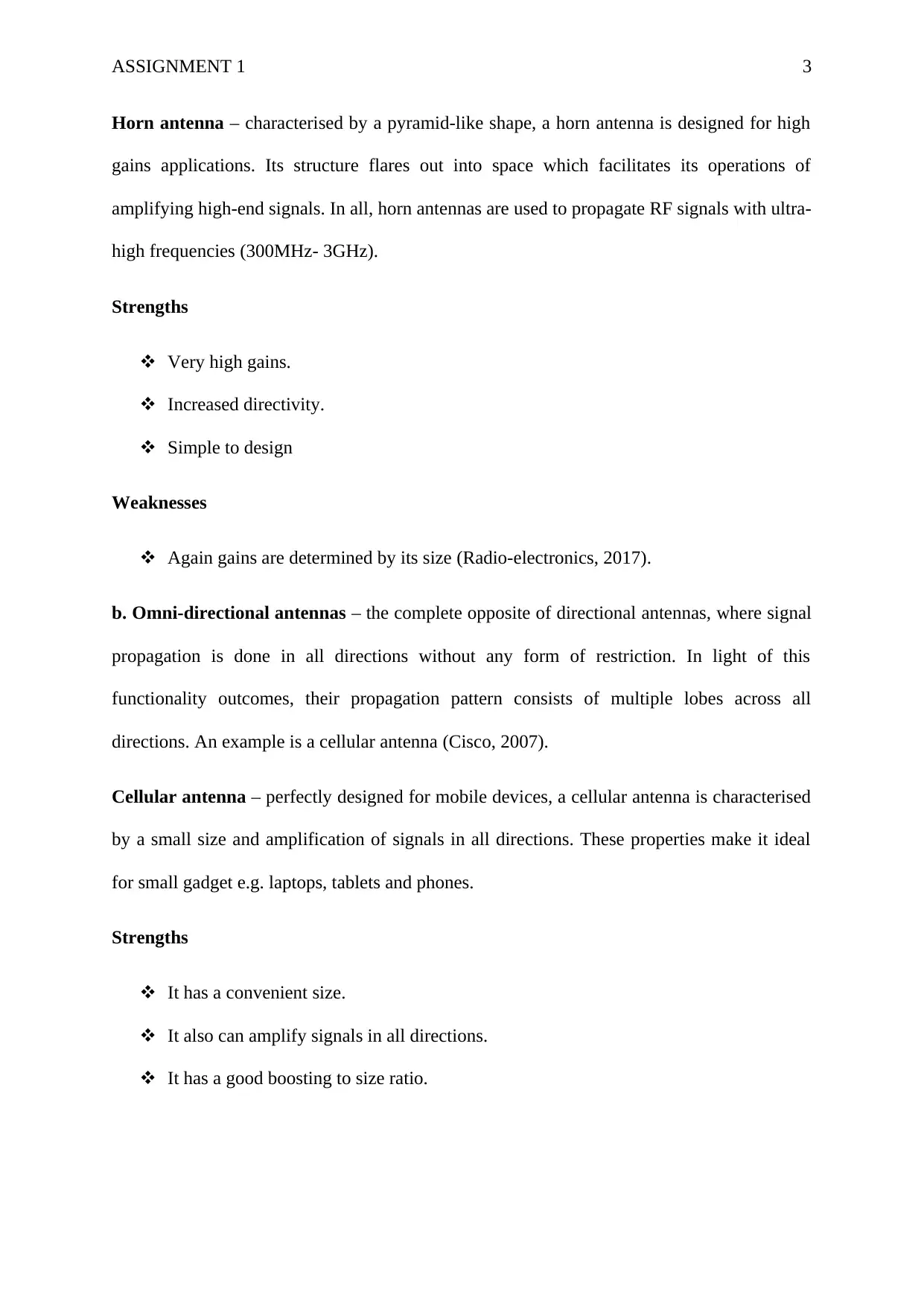
ASSIGNMENT 1 3
Horn antenna – characterised by a pyramid-like shape, a horn antenna is designed for high
gains applications. Its structure flares out into space which facilitates its operations of
amplifying high-end signals. In all, horn antennas are used to propagate RF signals with ultra-
high frequencies (300MHz- 3GHz).
Strengths
Very high gains.
Increased directivity.
Simple to design
Weaknesses
Again gains are determined by its size (Radio-electronics, 2017).
b. Omni-directional antennas – the complete opposite of directional antennas, where signal
propagation is done in all directions without any form of restriction. In light of this
functionality outcomes, their propagation pattern consists of multiple lobes across all
directions. An example is a cellular antenna (Cisco, 2007).
Cellular antenna – perfectly designed for mobile devices, a cellular antenna is characterised
by a small size and amplification of signals in all directions. These properties make it ideal
for small gadget e.g. laptops, tablets and phones.
Strengths
It has a convenient size.
It also can amplify signals in all directions.
It has a good boosting to size ratio.
Horn antenna – characterised by a pyramid-like shape, a horn antenna is designed for high
gains applications. Its structure flares out into space which facilitates its operations of
amplifying high-end signals. In all, horn antennas are used to propagate RF signals with ultra-
high frequencies (300MHz- 3GHz).
Strengths
Very high gains.
Increased directivity.
Simple to design
Weaknesses
Again gains are determined by its size (Radio-electronics, 2017).
b. Omni-directional antennas – the complete opposite of directional antennas, where signal
propagation is done in all directions without any form of restriction. In light of this
functionality outcomes, their propagation pattern consists of multiple lobes across all
directions. An example is a cellular antenna (Cisco, 2007).
Cellular antenna – perfectly designed for mobile devices, a cellular antenna is characterised
by a small size and amplification of signals in all directions. These properties make it ideal
for small gadget e.g. laptops, tablets and phones.
Strengths
It has a convenient size.
It also can amplify signals in all directions.
It has a good boosting to size ratio.
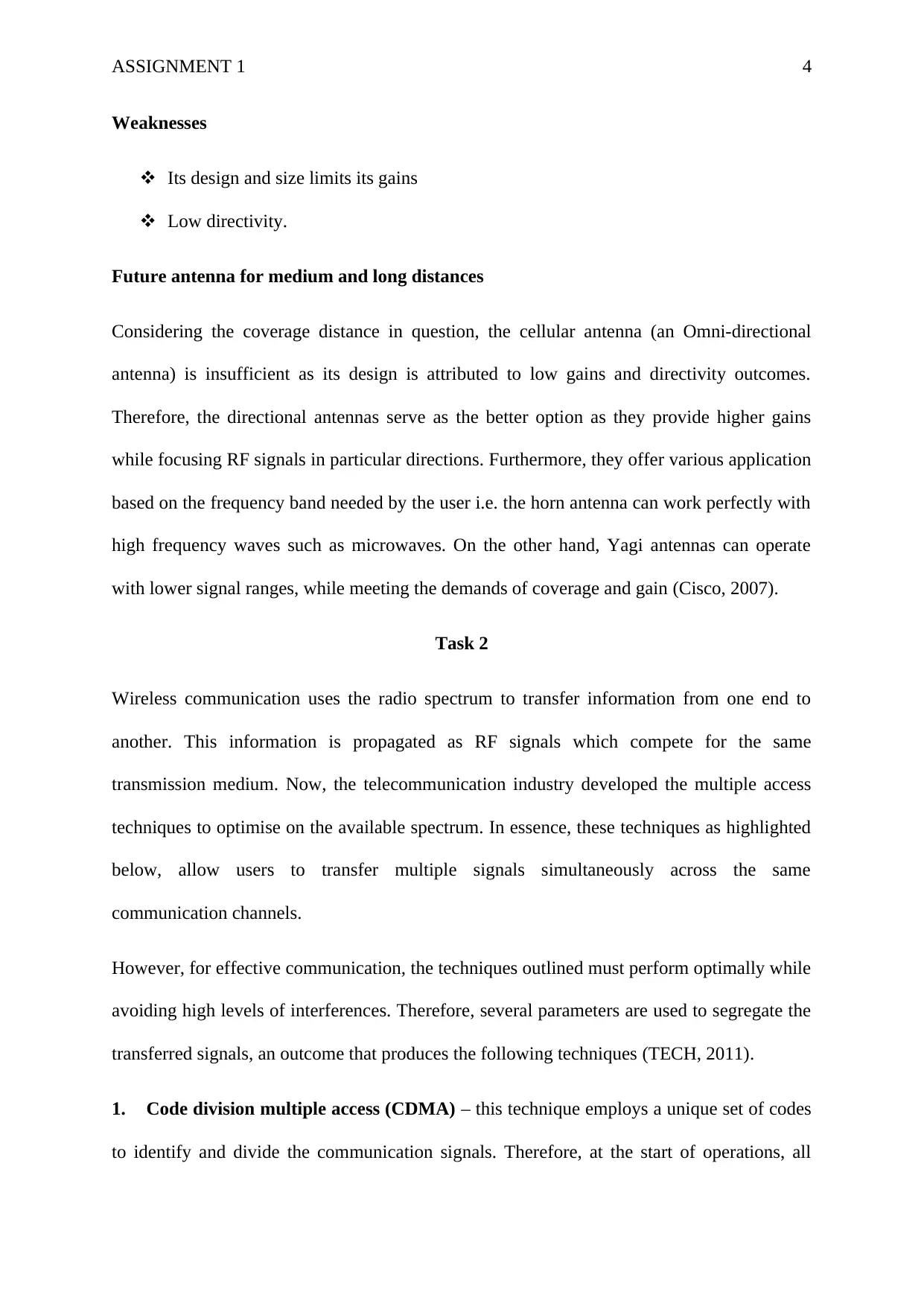
ASSIGNMENT 1 4
Weaknesses
Its design and size limits its gains
Low directivity.
Future antenna for medium and long distances
Considering the coverage distance in question, the cellular antenna (an Omni-directional
antenna) is insufficient as its design is attributed to low gains and directivity outcomes.
Therefore, the directional antennas serve as the better option as they provide higher gains
while focusing RF signals in particular directions. Furthermore, they offer various application
based on the frequency band needed by the user i.e. the horn antenna can work perfectly with
high frequency waves such as microwaves. On the other hand, Yagi antennas can operate
with lower signal ranges, while meeting the demands of coverage and gain (Cisco, 2007).
Task 2
Wireless communication uses the radio spectrum to transfer information from one end to
another. This information is propagated as RF signals which compete for the same
transmission medium. Now, the telecommunication industry developed the multiple access
techniques to optimise on the available spectrum. In essence, these techniques as highlighted
below, allow users to transfer multiple signals simultaneously across the same
communication channels.
However, for effective communication, the techniques outlined must perform optimally while
avoiding high levels of interferences. Therefore, several parameters are used to segregate the
transferred signals, an outcome that produces the following techniques (TECH, 2011).
1. Code division multiple access (CDMA) – this technique employs a unique set of codes
to identify and divide the communication signals. Therefore, at the start of operations, all
Weaknesses
Its design and size limits its gains
Low directivity.
Future antenna for medium and long distances
Considering the coverage distance in question, the cellular antenna (an Omni-directional
antenna) is insufficient as its design is attributed to low gains and directivity outcomes.
Therefore, the directional antennas serve as the better option as they provide higher gains
while focusing RF signals in particular directions. Furthermore, they offer various application
based on the frequency band needed by the user i.e. the horn antenna can work perfectly with
high frequency waves such as microwaves. On the other hand, Yagi antennas can operate
with lower signal ranges, while meeting the demands of coverage and gain (Cisco, 2007).
Task 2
Wireless communication uses the radio spectrum to transfer information from one end to
another. This information is propagated as RF signals which compete for the same
transmission medium. Now, the telecommunication industry developed the multiple access
techniques to optimise on the available spectrum. In essence, these techniques as highlighted
below, allow users to transfer multiple signals simultaneously across the same
communication channels.
However, for effective communication, the techniques outlined must perform optimally while
avoiding high levels of interferences. Therefore, several parameters are used to segregate the
transferred signals, an outcome that produces the following techniques (TECH, 2011).
1. Code division multiple access (CDMA) – this technique employs a unique set of codes
to identify and divide the communication signals. Therefore, at the start of operations, all
Secure Best Marks with AI Grader
Need help grading? Try our AI Grader for instant feedback on your assignments.
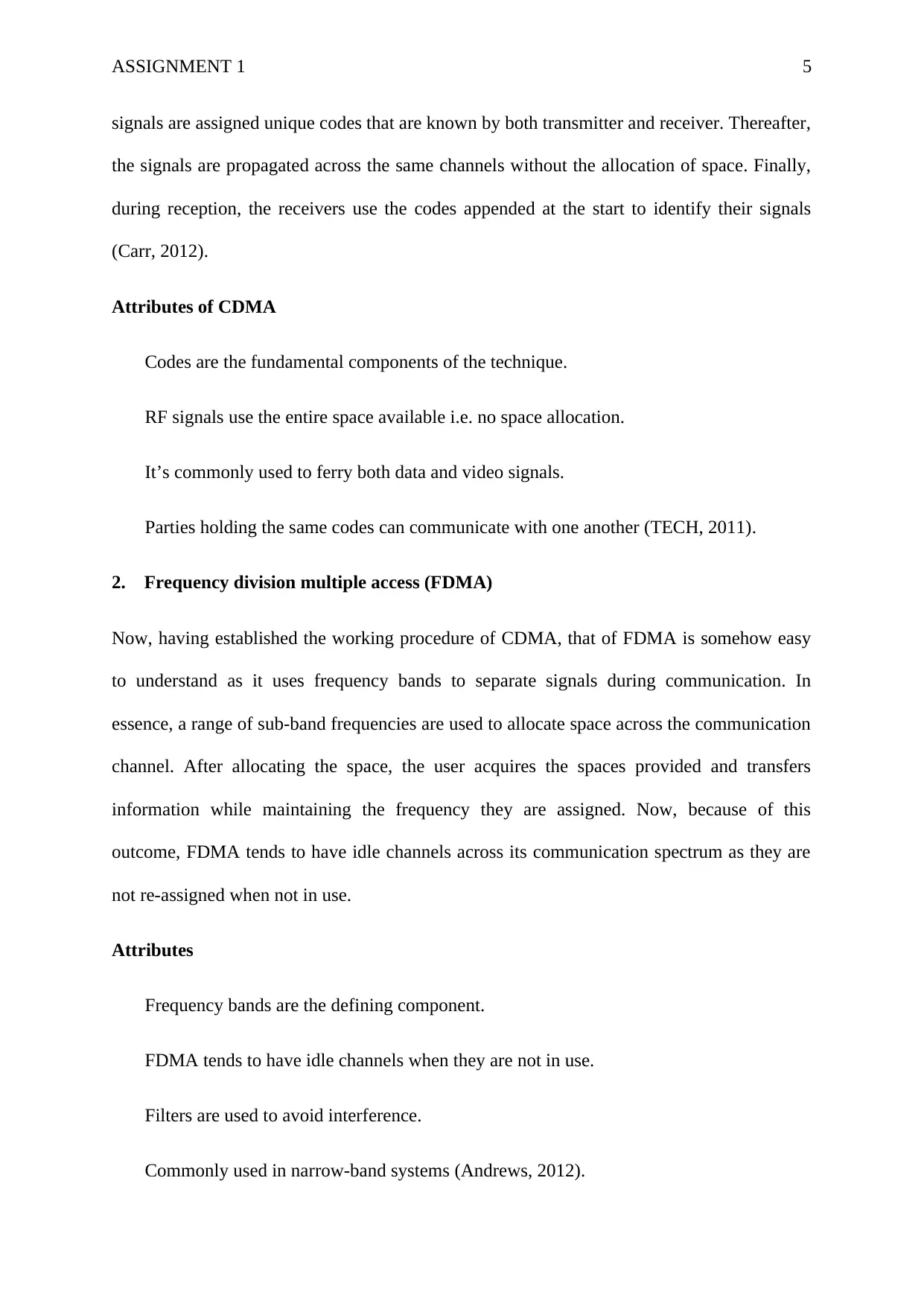
ASSIGNMENT 1 5
signals are assigned unique codes that are known by both transmitter and receiver. Thereafter,
the signals are propagated across the same channels without the allocation of space. Finally,
during reception, the receivers use the codes appended at the start to identify their signals
(Carr, 2012).
Attributes of CDMA
Codes are the fundamental components of the technique.
RF signals use the entire space available i.e. no space allocation.
It’s commonly used to ferry both data and video signals.
Parties holding the same codes can communicate with one another (TECH, 2011).
2. Frequency division multiple access (FDMA)
Now, having established the working procedure of CDMA, that of FDMA is somehow easy
to understand as it uses frequency bands to separate signals during communication. In
essence, a range of sub-band frequencies are used to allocate space across the communication
channel. After allocating the space, the user acquires the spaces provided and transfers
information while maintaining the frequency they are assigned. Now, because of this
outcome, FDMA tends to have idle channels across its communication spectrum as they are
not re-assigned when not in use.
Attributes
Frequency bands are the defining component.
FDMA tends to have idle channels when they are not in use.
Filters are used to avoid interference.
Commonly used in narrow-band systems (Andrews, 2012).
signals are assigned unique codes that are known by both transmitter and receiver. Thereafter,
the signals are propagated across the same channels without the allocation of space. Finally,
during reception, the receivers use the codes appended at the start to identify their signals
(Carr, 2012).
Attributes of CDMA
Codes are the fundamental components of the technique.
RF signals use the entire space available i.e. no space allocation.
It’s commonly used to ferry both data and video signals.
Parties holding the same codes can communicate with one another (TECH, 2011).
2. Frequency division multiple access (FDMA)
Now, having established the working procedure of CDMA, that of FDMA is somehow easy
to understand as it uses frequency bands to separate signals during communication. In
essence, a range of sub-band frequencies are used to allocate space across the communication
channel. After allocating the space, the user acquires the spaces provided and transfers
information while maintaining the frequency they are assigned. Now, because of this
outcome, FDMA tends to have idle channels across its communication spectrum as they are
not re-assigned when not in use.
Attributes
Frequency bands are the defining component.
FDMA tends to have idle channels when they are not in use.
Filters are used to avoid interference.
Commonly used in narrow-band systems (Andrews, 2012).
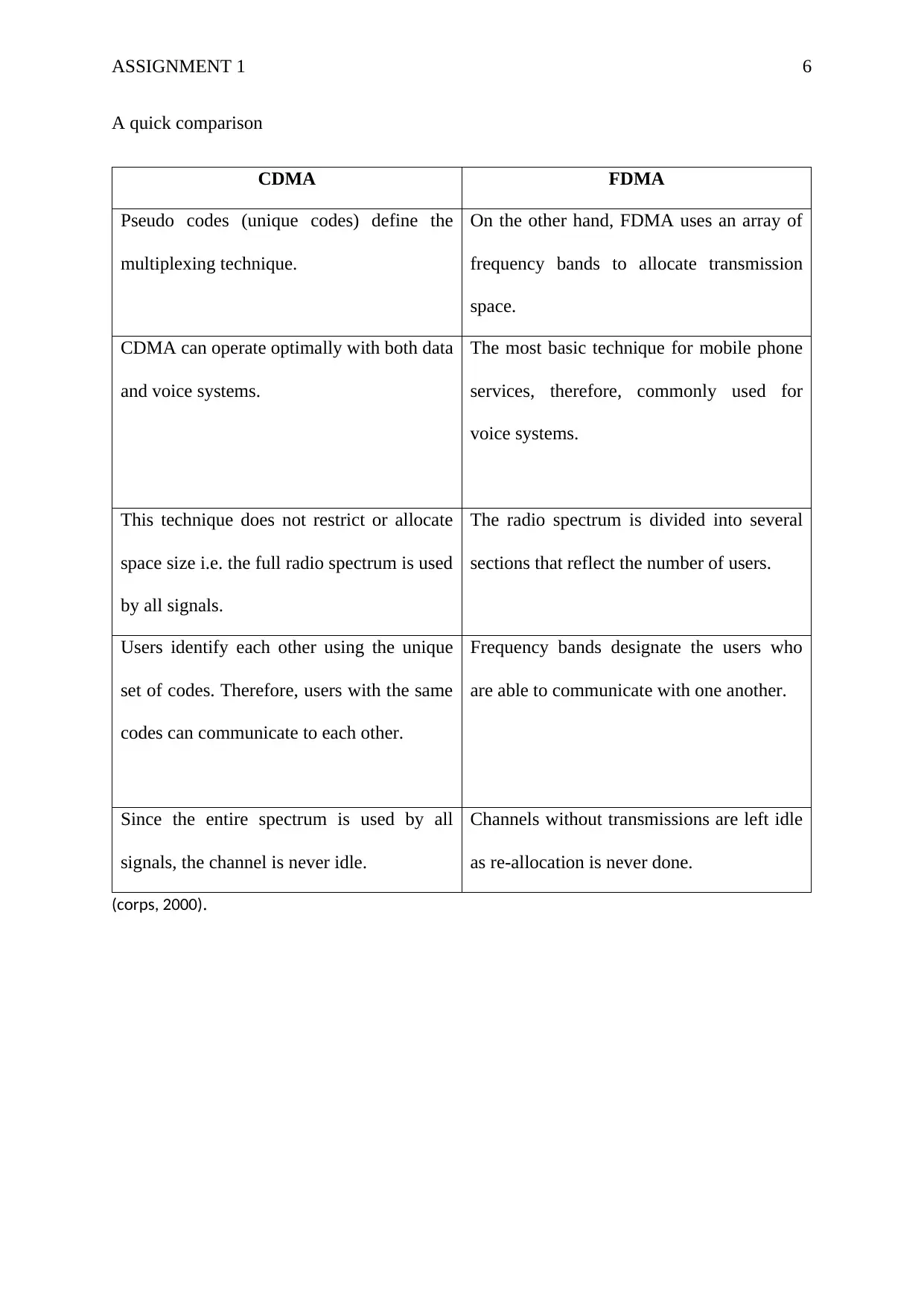
ASSIGNMENT 1 6
A quick comparison
CDMA FDMA
Pseudo codes (unique codes) define the
multiplexing technique.
On the other hand, FDMA uses an array of
frequency bands to allocate transmission
space.
CDMA can operate optimally with both data
and voice systems.
The most basic technique for mobile phone
services, therefore, commonly used for
voice systems.
This technique does not restrict or allocate
space size i.e. the full radio spectrum is used
by all signals.
The radio spectrum is divided into several
sections that reflect the number of users.
Users identify each other using the unique
set of codes. Therefore, users with the same
codes can communicate to each other.
Frequency bands designate the users who
are able to communicate with one another.
Since the entire spectrum is used by all
signals, the channel is never idle.
Channels without transmissions are left idle
as re-allocation is never done.
(corps, 2000).
A quick comparison
CDMA FDMA
Pseudo codes (unique codes) define the
multiplexing technique.
On the other hand, FDMA uses an array of
frequency bands to allocate transmission
space.
CDMA can operate optimally with both data
and voice systems.
The most basic technique for mobile phone
services, therefore, commonly used for
voice systems.
This technique does not restrict or allocate
space size i.e. the full radio spectrum is used
by all signals.
The radio spectrum is divided into several
sections that reflect the number of users.
Users identify each other using the unique
set of codes. Therefore, users with the same
codes can communicate to each other.
Frequency bands designate the users who
are able to communicate with one another.
Since the entire spectrum is used by all
signals, the channel is never idle.
Channels without transmissions are left idle
as re-allocation is never done.
(corps, 2000).
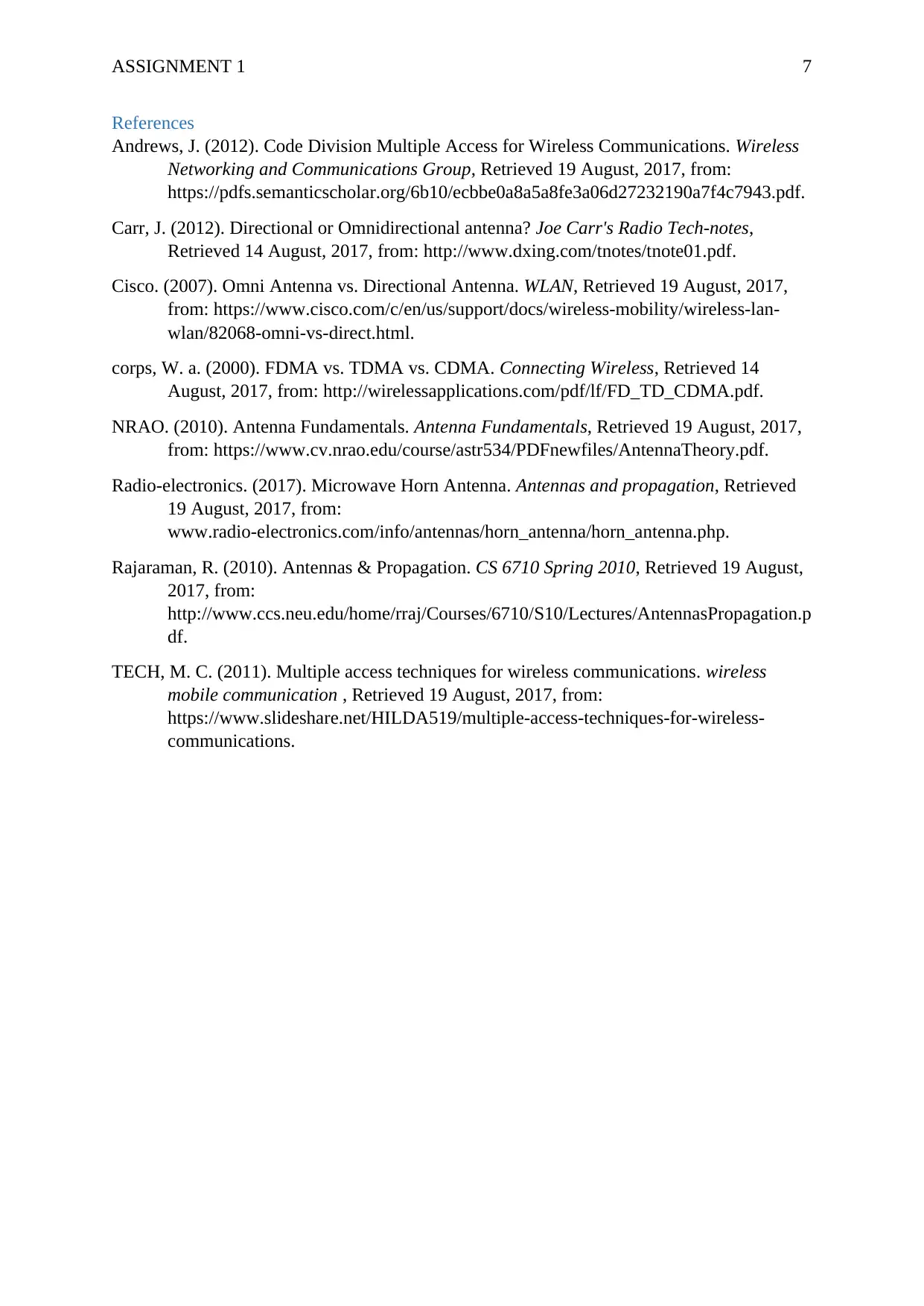
ASSIGNMENT 1 7
References
Andrews, J. (2012). Code Division Multiple Access for Wireless Communications. Wireless
Networking and Communications Group, Retrieved 19 August, 2017, from:
https://pdfs.semanticscholar.org/6b10/ecbbe0a8a5a8fe3a06d27232190a7f4c7943.pdf.
Carr, J. (2012). Directional or Omnidirectional antenna? Joe Carr's Radio Tech-notes,
Retrieved 14 August, 2017, from: http://www.dxing.com/tnotes/tnote01.pdf.
Cisco. (2007). Omni Antenna vs. Directional Antenna. WLAN, Retrieved 19 August, 2017,
from: https://www.cisco.com/c/en/us/support/docs/wireless-mobility/wireless-lan-
wlan/82068-omni-vs-direct.html.
corps, W. a. (2000). FDMA vs. TDMA vs. CDMA. Connecting Wireless, Retrieved 14
August, 2017, from: http://wirelessapplications.com/pdf/lf/FD_TD_CDMA.pdf.
NRAO. (2010). Antenna Fundamentals. Antenna Fundamentals, Retrieved 19 August, 2017,
from: https://www.cv.nrao.edu/course/astr534/PDFnewfiles/AntennaTheory.pdf.
Radio-electronics. (2017). Microwave Horn Antenna. Antennas and propagation, Retrieved
19 August, 2017, from:
www.radio-electronics.com/info/antennas/horn_antenna/horn_antenna.php.
Rajaraman, R. (2010). Antennas & Propagation. CS 6710 Spring 2010, Retrieved 19 August,
2017, from:
http://www.ccs.neu.edu/home/rraj/Courses/6710/S10/Lectures/AntennasPropagation.p
df.
TECH, M. C. (2011). Multiple access techniques for wireless communications. wireless
mobile communication , Retrieved 19 August, 2017, from:
https://www.slideshare.net/HILDA519/multiple-access-techniques-for-wireless-
communications.
References
Andrews, J. (2012). Code Division Multiple Access for Wireless Communications. Wireless
Networking and Communications Group, Retrieved 19 August, 2017, from:
https://pdfs.semanticscholar.org/6b10/ecbbe0a8a5a8fe3a06d27232190a7f4c7943.pdf.
Carr, J. (2012). Directional or Omnidirectional antenna? Joe Carr's Radio Tech-notes,
Retrieved 14 August, 2017, from: http://www.dxing.com/tnotes/tnote01.pdf.
Cisco. (2007). Omni Antenna vs. Directional Antenna. WLAN, Retrieved 19 August, 2017,
from: https://www.cisco.com/c/en/us/support/docs/wireless-mobility/wireless-lan-
wlan/82068-omni-vs-direct.html.
corps, W. a. (2000). FDMA vs. TDMA vs. CDMA. Connecting Wireless, Retrieved 14
August, 2017, from: http://wirelessapplications.com/pdf/lf/FD_TD_CDMA.pdf.
NRAO. (2010). Antenna Fundamentals. Antenna Fundamentals, Retrieved 19 August, 2017,
from: https://www.cv.nrao.edu/course/astr534/PDFnewfiles/AntennaTheory.pdf.
Radio-electronics. (2017). Microwave Horn Antenna. Antennas and propagation, Retrieved
19 August, 2017, from:
www.radio-electronics.com/info/antennas/horn_antenna/horn_antenna.php.
Rajaraman, R. (2010). Antennas & Propagation. CS 6710 Spring 2010, Retrieved 19 August,
2017, from:
http://www.ccs.neu.edu/home/rraj/Courses/6710/S10/Lectures/AntennasPropagation.p
df.
TECH, M. C. (2011). Multiple access techniques for wireless communications. wireless
mobile communication , Retrieved 19 August, 2017, from:
https://www.slideshare.net/HILDA519/multiple-access-techniques-for-wireless-
communications.
1 out of 7
Related Documents
Your All-in-One AI-Powered Toolkit for Academic Success.
+13062052269
info@desklib.com
Available 24*7 on WhatsApp / Email
![[object Object]](/_next/static/media/star-bottom.7253800d.svg)
Unlock your academic potential
© 2024 | Zucol Services PVT LTD | All rights reserved.





